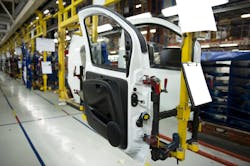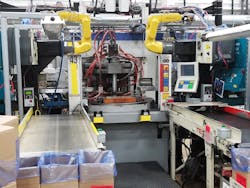When developing an optimal product or part design that fulfills the goals set out by the product development department, the material you choose has the potential to make a big difference. Materials can make or break your ability to fulfill design specifications and product functionality. Finding the right material can even exceed your original concept, especially if you’re considering resins.
Since the Iron Age, metal has been the material of choice thanks to its malleability and strength. However, designers today are applying plastics to a growing array of product parts and components. Polymers have several advantages over metal. For example, polymers can reduce weight and processing time.
Metal-to-plastic conversions for complex injection-molded components are becoming more common in product development. This brief comparison reveals why.
Metal parts:
- Require expensive, high-precision machining
- Must be individually machined
- Need secondary finishing to prevent corrosion
- Conduct heat in high-temperature applications
Plastic parts:
- Require only one mold
- Can be produced quickly and easily in large volumes
- Are naturally corrosion-resistant, eliminating most secondary finishing operations
- Serve as insulators in high-heat applications because of slow heat conduction
The ascendancy of plastic is happening as polymer science makes tremendous strides in research and development, leading to rampant growth in materials choices. At the same time, rapid advancements in the ability to compound a variety of resins with fillers and reinforcements can provide a tremendous amount of structural integrity.
With proper material selection paired with design optimization, plastic components can be as strong as metal, weigh less, and potentially provide tremendous versatility. There is a nearly infinite number of engineering-grade resin and filler combinations available. When determining which of these materials is best-suited for your project, time spent engaging with an experienced injection molder is well worth it.
Addressing resin needs early in the design process with an injection molding partner is ideal. A molder’s in-depth knowledge will guide you to the most efficient and cost-effective processes for your industrial applications. Their expert knowledge of performance characteristics can also afford you the ability to maximize product benefits to the user.
Here are key considerations for assessing your project from a materials perspective, including specs, resin attributes, and molding performance factors.
When using the overmolding process, careful consideration of how the rigid substrate and the rubber overmold material will interact is needed. In the case of devices such as these, overmolding provides greater impact resistance.
Focusing on Product Use Environment
When it comes to choosing the resin or resin compound that will be used in the molding of your project, knowing how the final product will be used, where it will be used, and the demands it will be placed under gets you closer to making the best selection. The factors to consider include:
- Strength
- Rigidity
- Chemical resistance
- Temperature resistance
- Flexibility
- Impact resistance
- Appearance
- Conductivity/shielding
- Frictional properties
- Flame resistance
Prioritizing these attributes gives you the means to sort out the available resins that will enhance your ultimate product.
By weighing these options in direct relation to your application, you’ll eliminate a lot of guesswork and possible backtracking when it comes to selecting the right resin. Here are some further detailed considerations that will identify the proper material:
- Physical load. What are the expectations for impact and weight-bearing demands to ensure the material will stand up to the conditions of everyday fatigue, plus meet any safety requirements?
- Part mechanical function. Can the product/part withstand torque and required cycles?
- Thermal conditions. Will the product/part need to withstand fluctuating and extreme temperatures?
- Chemical exposure. Will the product/part be subjected to industrial environments and/or operations that could introduce harsh substances that could erode or distort plastic components, such as greases, oils, or solvents?
- Use of dissimilar materials. The formulation may require multi-shot technology or overmolding (a process by which a single part is created using two or more different materials in combination) to ensure effective resin interplay and compatibility with other system components.
- High-heat resin application. Materials in this category are more difficult to work with, due to higher melting points. These qualities require careful assessment of all application aspects, from safety to the molding processes.
Resin Selection
Evaluating your project needs narrows the breadth of materials appropriate for the product or part. A resin’s attributes will determine the correct material to match up with the part’s requirements.
Plastics are replacing metal in many applications.
Durability
Manufacturers who produce rugged electronic equipment have customers that count on their devices to perform in challenging real-life conditions and survive impact, shock, and vibration. Therefore, impact resistance drives selection of polycarbonate (PC), acrylonitrile butadiene styrene (ABS), polyethylene terephthalate (PET), and nylon for molding rugged housings.
To increase a product’s ability to withstand jolts and drops, injection molders can add elastomeric polymers to the melt. Because these additives are elastic in nature, they deform upon impact without failing, and their material memory recovers their original shape even after stretching, compression, or twisting. These compounds are an ideal solution for products that face these risks, such as housings for devices or mounting structures.
Almost all elastomeric materials bend under impact at low hardness levels, but they tend to become more brittle as they are engineered for higher hardness. Polyurethane elastomers that retain the most flexibility are a good choice when design specifications require high hardness, in addition to ruggedness/impact resistance. Overmolding thermoplastic elastomers on the product exterior substrate can improve impact resistance, and doing so on the product interior can further protect delicate components from shock and vibration.
Reinforcing fillers added to resin formulas improve mechanical properties and include:
- Glass fibers
- Carbon
- Stainless steel
- Kevlar
Tight Tolerances
Different resins can produce inconsistent tolerances for the same part, so sometimes a tradeoff must be made between tolerance expectations and the physical properties of the resin. Holding tight tolerances can be a challenge with many resins because they have different shrink rates, high thermal expansion rates, moisture absorption, and—in the case of crystalline materials—may continue to grow crystals after the molding process. Even though injection molders can hold plastic components to tight tolerances in a climate-controlled environment, these dimensions may not hold as the temperature or humidity levels change.
This characteristic must be considered when plastics are combined with fillers, when they must interact with other material types (such as metals), or when the end use occurs in environments where temperature and humidity levels greatly fluctuate.
With regard to maintaining tight tolerances, injection molders consider the characteristics of two types of plastics. Amorphous plastics have random polymer chain orientations, giving the plastic a formless structure with good impact strength and toughness. Acrylonitrile-butadiene-styrene (ABS), styrene-acrylonitrile-copolymer (SAN), polyvinyl chloride (PVC), polycarbonate (PC) and polystyrene (PS) are good examples of amorphous plastics.
The composition of crystalline plastics is orderly, densely packed polymer chains. This family of plastics have lower elongation and flexibility than amorphous plastics, but better chemical resistance. Acetal, polyamide (PA), polyethylene (PE), polypropylene (PP), polyester (PET/PBT), and polyphenylene sulfide (PPS) are good examples of crystalline plastics.
Plastics offer an array of choices to match the needs of the application.
High Temperature
One of the biggest challenges in using high-temperature resins is that melt temperatures are extremely high—exceeding 700°F in most applications. Molten resins behave differently at such high temperatures, introducing the potential for polymer degradation and inferior parts that need to be redone.
High-quality products are dependent on careful temperature control and the resin chosen. Popular high-temperature plastics include polyphtalamide (PPA), polyphenylene sulfide (PPS), polysulfone (PSU), polyetherimide (PEI), polyether ether ketone (PEEK), polyamide-imides (PAIs), ethylene tetrafluoroethylene (ETFE) and polyethersulfone (PES). Applications for these high heat resins include cowlings on lawn and home equipment, and components positioned near the engine block of snow blowers.
Conductivity
Many of today’s designs incorporate specialty injection-molding resins that have superior thermal conductivity, such as commercial and automotive LED lighting heatsinks. These compounds can also be used in products for replacing aluminum. Manufacturers of these applications can use nanotechnology to produce tiny metal fibers and strands that are incorporated into the polymer matrix to influence the conductive performance of the composite material.
Material suppliers can infuse polycarbonate (PC), polypropylene, ABS, polyamide 6/6, and PC/ABS resins with conductive stainless steel fiber or nickel-plated carbon fiber fillers. While the injection molding produces complex plastic parts that may not be as hard, durable, or conductive as the metallic parts they replace, they are adequate for the application. In addition, they provide other benefits, such as being of substantially lighter weight and often lower in cost.
Particulate fillers increase the modulus of elasticity and electrical conductivity to improve heat and ultraviolet light resistance. These fillers also reduce costs. Common particulate fillers include:
- Mineral
- Silica
- Ceramic
- Carbon powder/fiber
- Glass microspheres/fibers
- Powdered metal
Unique Characteristics
In some cases, the design engineer finds the desired product characteristics are not clearly defined. For example, a manufacturer needing a complex garbage disposal component must consider not only the performance of that component on its own, but its interaction with the larger system. In this case, the rigid plastic housing would need to withstand rigorous requirements of the machine in operation, while also being compatible with the internal seals and related plastic, metal, and rubber components.
Overmolding can help prevent leaks, but then the selection of resin for the rigid substrate must take into account the rubber overmold material. Here, polypropylene with glass fibers could be an excellent choice for the substrate.
Polypropylene itself is relatively inexpensive. Adding glass fibers makes the part rigid enough to stand up to the structural requirements of the project, yet also be compatible with the rubber overmolding material. Proper processing is essential. The glass fibers will reduce adhesion if allowed to reach the surface.
Reinforcing fillers improve mechanical properties and include:
- Glass fibers
- Carbon
- Stainless steel
- Kevlar
On the Injection Molder’s Plant Floor
Just like you are an expert on the intended performance of your applications, experienced complex injection molders have a deep understanding of how resins perform during production.
Specially trained injection molding engineers are knowledgeable about scientific molding so they can better control the processes and other factors that influence successful product outcomes. Here are some insights into the criteria for injection molding.
Design: Getting the molder involved early in the design process is crucial to the success of the project. Critical changes to the design may be required, depending on the material selected and the injection-molded process. In some instances, the selected material may add an unanticipated benefit to part of the product.
For example, high-temperature resins are very sensitive to nominal wall sections and knit lines. Depending on the material and temperature, differential shrink rates may result in unwanted voids and other flaws. An experienced molder can develop viscosity curves for each specific resin to simulate the molding process early on, allowing engineers to minimize shrink rates and optimize the final molding process.
Tool steel: For high-volume production, it is cost-effective to invest in high-quality tooling to avoid excessive tool wear. Draft, finish, undercuts, and steel types should all be considered during product/part design. The type of steel selected for the mold will depend on the amount of abrasive fillers in the engineered resin.
Press size: Machines need to be properly sized so the correct residence time of the melt is not exceeded. Too much residence time degrades the properties of the melt and can result in inferior molded parts with visible surface flaws, such as discoloration and burn marks.
Moisture content: Some plastics are hygroscopic and absorb moisture, which can alter material behavior during the injection molding process. Even small concentrations of moisture in the melt can affect material viscosity enough to cause dimensional and aesthetic problems.
Venting: Proper location and size of the tooling vents are critical to consistent processing and for the tooling function. Vents allow trapped air and volatiles to escape from the tooling cavity. An increased concentration of volatiles can plug vents faster and cause plastic brittleness, burn marks, other surface imperfections, and poor knit line strength—all of which reduce the quality and performance of the part.
Cooling: Cooling is perhaps the most important process step in molding, especially for applications using high-temperature resins. Selecting the proper technique—conveyors, hot oil, and pressurized water—prevents negative impacts ranging from variable shrinkage to imprecise dimensional stability. For example, nylon is extremely susceptible to warping, but an experienced injection molding engineer will know where to place cooling channels in the tool to control and prevent this.
Injection molding experts have a deep understanding of how different resins perform during production.
Plastics Extend Your Design Capabilities
Market demands are leading to the development of products that are durable, deliver high performance, and offer improved aesthetics. The array of resin compounds means that designers can stretch their imaginations to achieve optimal product usability, compatibility, appearance, and endurance.
In the case of an abundance of plastics choices, material selection is less of a hindrance and more of an opportunity to exceed product expectations. Therefore, it is to the benefit of the project to bring on the advice of an injection molding partner early in the design process to identify materials that can meet the product or part standards that product development has in mind. These discussions are not just about what the material can or cannot do, but how the design can respond to the capabilities of the plastic compounds you have in mind.
By working closely with design engineers, an experienced, complex injection molder can understand product requirements and analyze the suitability of the selected materials. This proactive approach results in a more successful and cost-effective project design.
Al Timm is a senior business development engineer for Kaysun Corporation, which offers custom injection molding and engineering solutions to OEMs for the design, manufacture, and assembly of complex, tight-tolerance plastic parts.





